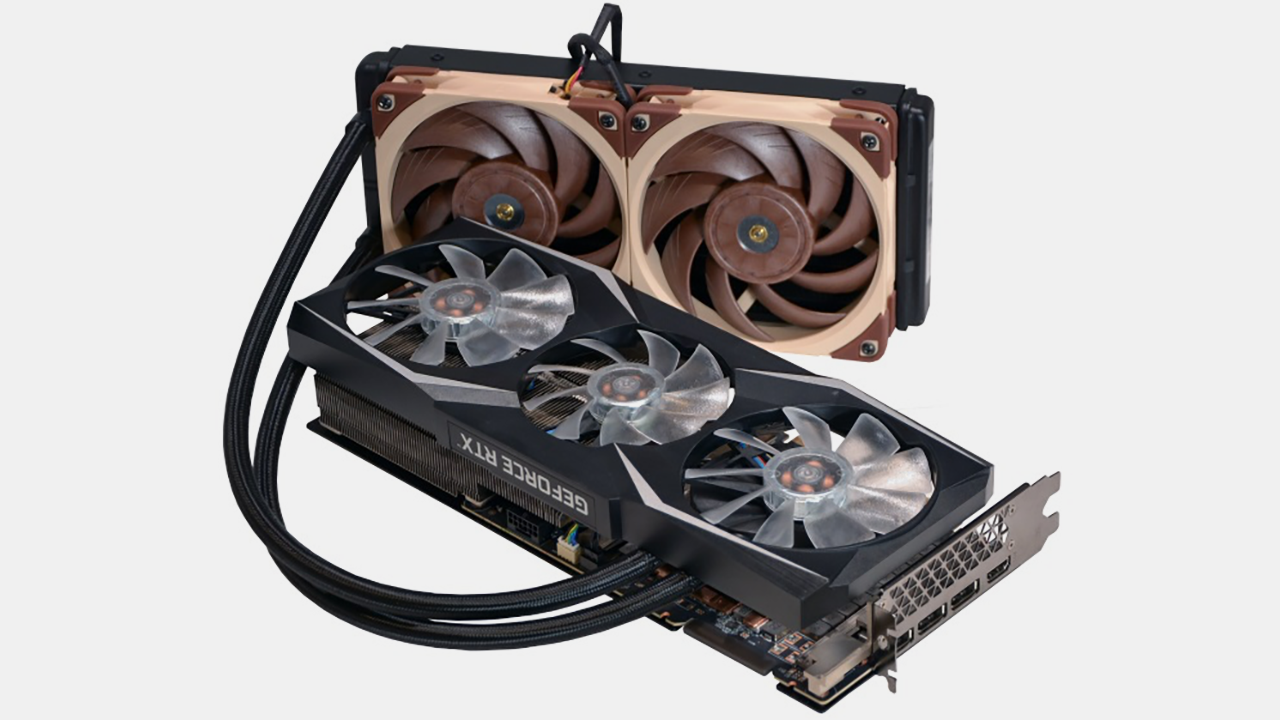This RTX 3090 Ti is cooled by no less than five fans
A sign of things to come?

With smart engineering, some cards run surprisingly cool, like the Asus TUF RTX 3090 Ti, which recorded a peak temperature of under 70 degrees in our review. The RTX 3090 Ti isn't one of them, and it's been well-documented how hot it can run due to its high TDP rating.
Asus' triple fan TUF cooler might be huge, but why settle for three fans when you can include a 240mm AIO as well? Japanese PC maker Sycom can build you a system with an RTX 3090 Ti that comes with a triple fan air cooler and a 240mm AIO. Yes, that's a graphics card with five fans.
The Sycom GeForce RTX 3090 Ti comes an Asetek 240mm radiator that's cooled by a pair of excellent Noctua NF-A12x25 ULN fans. ULN stands for ultra-low noise which means that the AIO part of the card will hardly be heard, even under a full load. According to Hermitage Akihabara and Tom's Hardware, the AIO is used to cool the GPU and GDDR6X memory while the VRM of the board is cooled by the triple fan air cooler.
Sycom claim that this cooler design reduces temperatures by up to 15 degrees Celsius compared to a standard air-cooled card, saying the card can hold a long-term boost clock of over 1800MHz at a temperature of 65 Celsius. That's a great result for a card that can draw easily over 400W.

Best CPU for gaming: The top chips from Intel and AMD
Best gaming motherboard: The right boards
Best graphics card: Your perfect pixel-pusher awaits
Best SSD for gaming: Get into the game ahead of the rest
Sycom's RTX 3090 Ti isn't the first hybrid card. There are several AIO equipped models but they've tended to be flagship models like EVGA's Kingpin or Asus' Strix LCS. But with TDPs set to rise to unprecedented levels, it's clear that GPU manufacturers are increasingly going to have to resort to ever more powerful cooling designs in order to tame them.
A single large cooler can do it, but sometimes this can have an unwanted heating effect. A card that outputs so much heat inside a case creates a heating feedback loop. Fans that direct 40 or 50 degree air onto a heatsink isn't going to function optimally. An AIO can send hot air outside of the case instead of recirculating it. It's a logical solution to the ever-increasing heat problem.
I believe we'll see many next generation cards cooled by AIOs. The high-end ones that is. If we assume that 600W or higher TDPs are going to become the new normal for high end graphics cards, look for more unconventional designs. Cards that take up four slots are already here. Will a manufacturer create a massive five slot next gen card? If there's a chance that a 900W graphics card will appear, then even that won't be enough.
Keep up to date with the most important stories and the best deals, as picked by the PC Gamer team.
Hybrid AIO and air-cooling solutions seem like a safer bet, but that means they'll be more expensive. We've all gotten used to paying through the nose for graphics cards though, right?

Chris' gaming experiences go back to the mid-nineties when he conned his parents into buying an 'educational PC' that was conveniently overpowered to play Doom and Tie Fighter. He developed a love of extreme overclocking that destroyed his savings despite the cheaper hardware on offer via his job at a PC store. To afford more LN2 he began moonlighting as a reviewer for VR-Zone before jumping the fence to work for MSI Australia. Since then, he's gone back to journalism, enthusiastically reviewing the latest and greatest components for PC & Tech Authority, PC Powerplay and currently Australian Personal Computer magazine and PC Gamer. Chris still puts far too many hours into Borderlands 3, always striving to become a more efficient killer.

